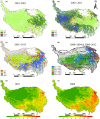Current challenges in distinguishing climatic and anthropogenic contributions to alpine grassland variation on the Tibetan Plateau
- PMID: 29938105
- PMCID: PMC6010758
- DOI: 10.1002/ece3.4099
Current challenges in distinguishing climatic and anthropogenic contributions to alpine grassland variation on the Tibetan Plateau
Abstract
Quantifying the impact of climate change and human activities on grassland dynamics is an essential step for developing sustainable grassland ecosystem management strategies. However, the direction and magnitude of climate change and human activities in driving alpine grassland dynamic over the Tibetan Plateau remain under debates. Here, we systematically reviewed the relevant studies on the methods, main conclusions, and causes for the inconsistency in distinguishing the respective contribution of climatic and anthropogenic forces to alpine grassland dynamic. Both manipulative experiments and traditional statistical analysis show that climate warming increase biomass in alpine meadows and decrease in alpine steppes, while both alpine steppes and meadows benefit from an increase in precipitation or soil moisture. Overgrazing is a major factor for the degradation of alpine grassland in local areas with high level of human activity intensity. However, across the entire Tibetan Plateau and its subregions, four views characterize the remaining controversies: alpine grassland changes are primarily due to (1) climatic force, (2) nonclimatic force, (3) combination of anthropogenic and climatic force, or (4) alternation of anthropogenic and climatic force. Furthermore, these views also show spatial inconsistencies. Differences on the source and quality of remote sensing products, the structure and parameter of models, and overlooking the spatiotemporal heterogeneity of human activity intensity contribute to current disagreements. In this review, we highlight the necessity for taking the spatiotemporal heterogeneity of human activity intensity into account in the models of attribution assessment, and the importance for accurate validation of climatic and anthropogenic contribution to alpine grassland variation at multiple scales for future studies.
Keywords: Tibetan Plateau; alpine grassland; climate change; degradation; human activity intensity; validation.
Figures





Similar articles
-
Disentangling climatic and anthropogenic contributions to nonlinear dynamics of alpine grassland productivity on the Qinghai-Tibetan Plateau.J Environ Manage. 2021 Mar 1;281:111875. doi: 10.1016/j.jenvman.2020.111875. Epub 2020 Dec 28. J Environ Manage. 2021. PMID: 33378737
-
Assessment of the vulnerability of alpine grasslands on the Qinghai-Tibetan Plateau.PeerJ. 2020 Feb 6;8:e8513. doi: 10.7717/peerj.8513. eCollection 2020. PeerJ. 2020. PMID: 32071818 Free PMC article.
-
Climate shapes the spatial pattern in local β-diversity of alpine grasslands on the Tibetan Plateau.Sci Total Environ. 2025 Mar 20;970:178977. doi: 10.1016/j.scitotenv.2025.178977. Epub 2025 Mar 3. Sci Total Environ. 2025. PMID: 40037235
-
[Vegetation and soil characteristics of degraded alpine meadows on the Qinghai-Tibet Pla-teau, China: A review].Ying Yong Sheng Tai Xue Bao. 2020 Jun;31(6):2109-2118. doi: 10.13287/j.1001-9332.202006.002. Ying Yong Sheng Tai Xue Bao. 2020. PMID: 34494765 Review. Chinese.
-
Alpine vegetation in the context of climate change: A global review of past research and future directions.Sci Total Environ. 2020 Dec 15;748:141344. doi: 10.1016/j.scitotenv.2020.141344. Epub 2020 Aug 2. Sci Total Environ. 2020. PMID: 32814293 Review.
Cited by
-
Impacts of climate change and human activities on different degraded grassland based on NDVI.Sci Rep. 2022 Sep 23;12(1):15918. doi: 10.1038/s41598-022-19943-6. Sci Rep. 2022. PMID: 36151254 Free PMC article.
-
Analyzing nonlinear contributions from climate change and anthropogenic activity to the normalized difference vegetation index across China using a locally weighted regression approach.Heliyon. 2023 May 25;9(6):e16694. doi: 10.1016/j.heliyon.2023.e16694. eCollection 2023 Jun. Heliyon. 2023. PMID: 37292263 Free PMC article.
-
High species richness of sheep-grazed sand pastures is driven by disturbance-tolerant and weedy short-lived species.Ecol Evol. 2024 Sep 8;14(9):e70282. doi: 10.1002/ece3.70282. eCollection 2024 Sep. Ecol Evol. 2024. PMID: 39247166 Free PMC article.
-
Assessing the spatial occupation and ecological impact of human activities in Chengguan district, Lhasa city, Tibetan Plateau.Sci Rep. 2024 Mar 23;14(1):6967. doi: 10.1038/s41598-024-57221-9. Sci Rep. 2024. PMID: 38521805 Free PMC article.
-
Exploring the frontiers of sustainable livelihoods research within grassland ecosystem: A scientometric analysis.Heliyon. 2022 Sep 22;8(10):e10704. doi: 10.1016/j.heliyon.2022.e10704. eCollection 2022 Oct. Heliyon. 2022. PMID: 36203909 Free PMC article.
References
-
- Allan, J. R. , Venter, O. , Maxwell, S. , Bertzky, B. , Jones, K. , Shi, Y. , & Watson, J. E. (2017). Recent increases in human pressure and forest loss threaten many natural world heritage sites. Biological Conservation, 206, 47–55. https://doi.org/10.1016/j.biocon.2016.12.011 - DOI
-
- Allan, J. R. , Venter, O. , & Watson, J. E. M. (2017). Temporally inter‐comparable maps of terrestrial wilderness and the last of the wild. Scientific Data, 4, 170187 https://doi.org/10.1038/sdata.2017.187 - DOI - PMC - PubMed
-
- Bai, W. , Zhang, Y. , Xie, G. , & Shen, Z. (2002). Analysis of formation causes of grassland degradation in maduo county in the source region of yellow river. The Journal of Applied Ecology, 13, 823–826. - PubMed
-
- Bateman, I. J. , Harwood, A. R. , Mace, G. M. , Watson, R. T. , Abson, D. J. , Andrews, B. , … Termansen, M. (2013). Bringing ecosystem services into economic decision‐making: Land use in the united kingdom. Science, 341, 45–50. https://doi.org/10.1126/science.1234379 - DOI - PubMed
-
- Cai, H. , Yang, X. , & Xu, X. (2015). Human‐induced grassland degradation/restoration in the central Tibetan Plateau: The effects of ecological protection and restoration projects. Ecological Engineering, 83, 112–119. https://doi.org/10.1016/j.ecoleng.2015.06.031 - DOI
Publication types
LinkOut - more resources
Full Text Sources
Other Literature Sources

